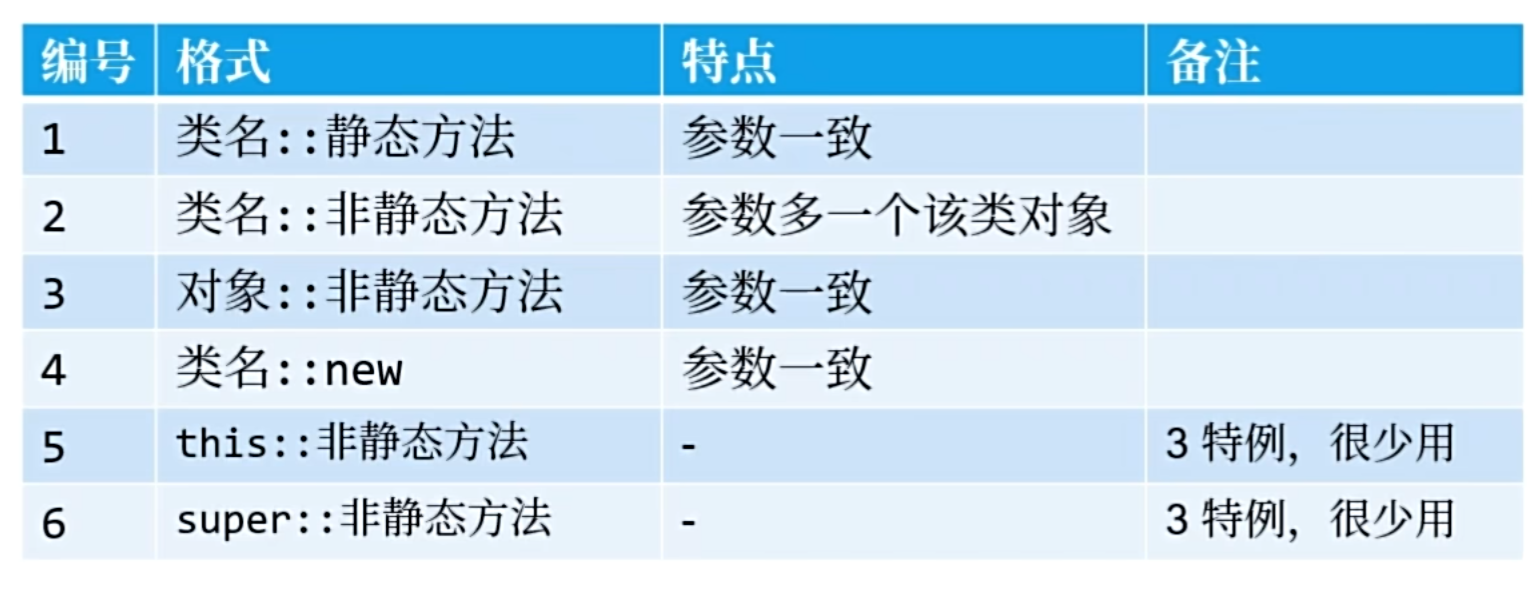1.函数对象表现形式
1.Lambda表达式(功能全面)
1.基本语法
2.只有一行逻辑,该逻辑结果是返回值

3.复杂逻辑

4.省略参数类型(可以通过上下文推导出类型时,比如实现了函数式接口)

5.只有一个参数时,参数的圆括号可以省略,但是也不能加参数类型

2.方法引用(写法简洁)
1.类型调用静态方法

2.类型调用成员方法(函数是以对象为基本单位的)

3.对象调用非静态方法

4.类型创建对象

3.练习
1.判断Lambda表达式正确性
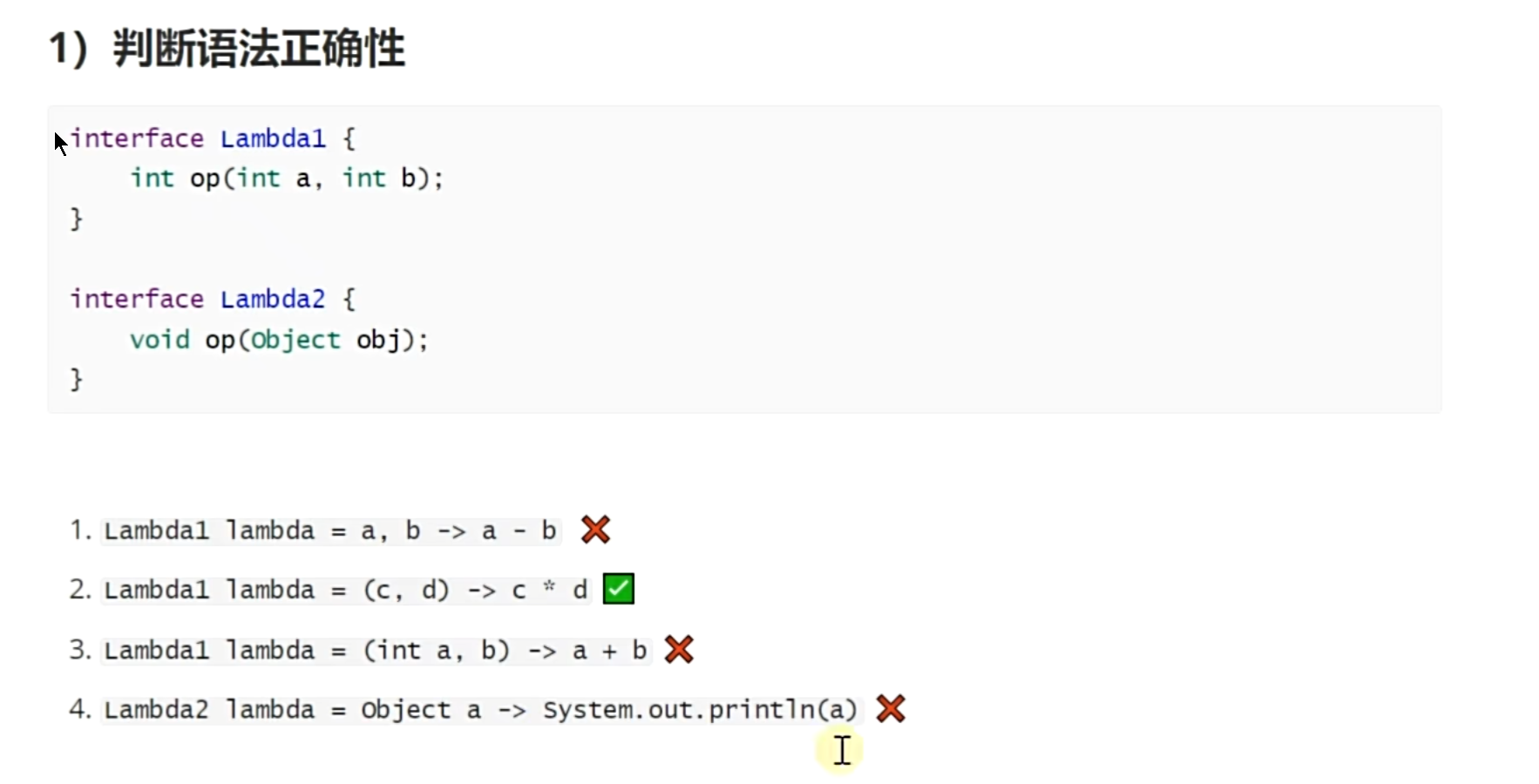
2.方法引用转换为Lambda表达式(要素:逻辑,参数,返回值)
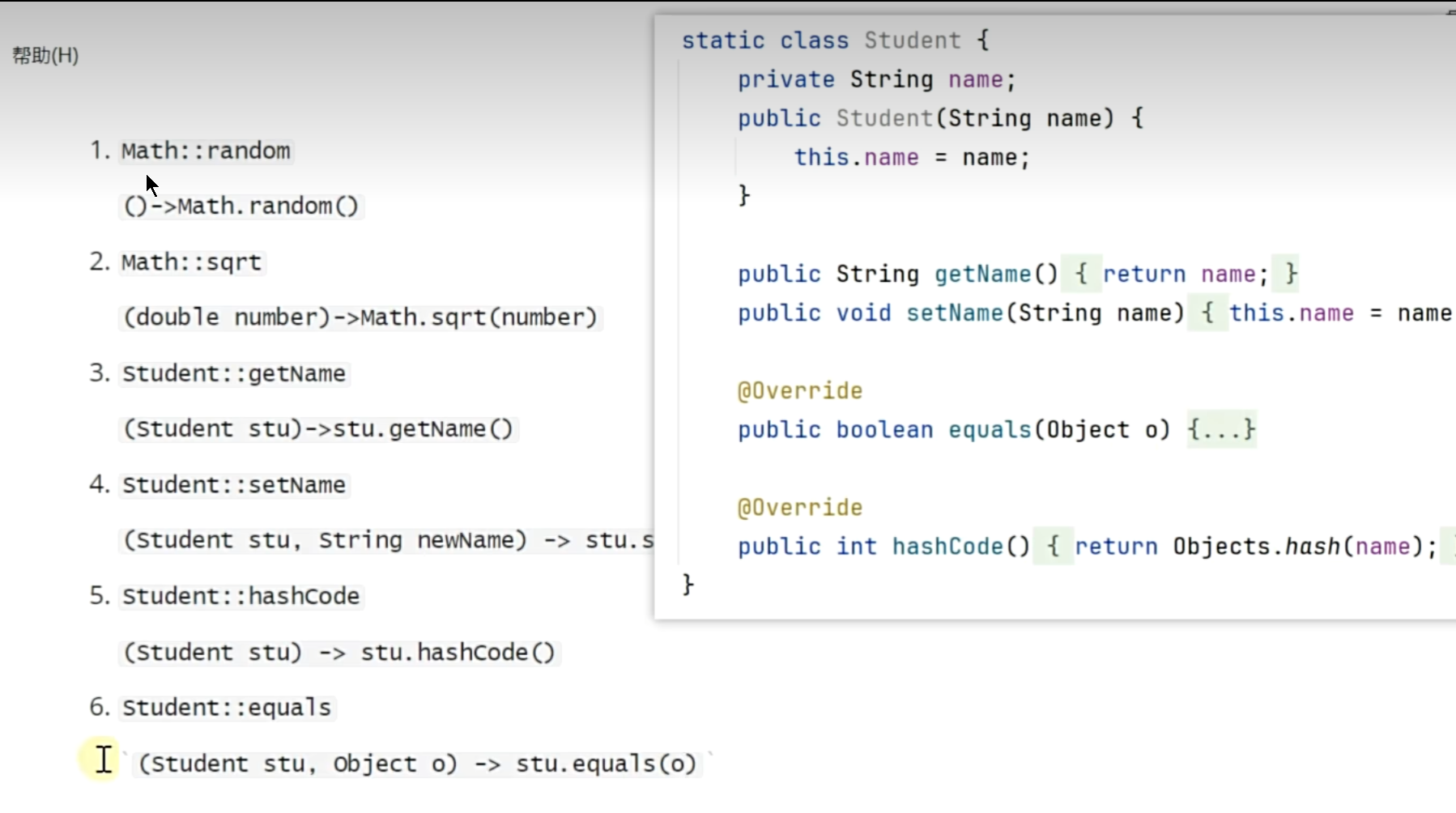
3.方法引用实例
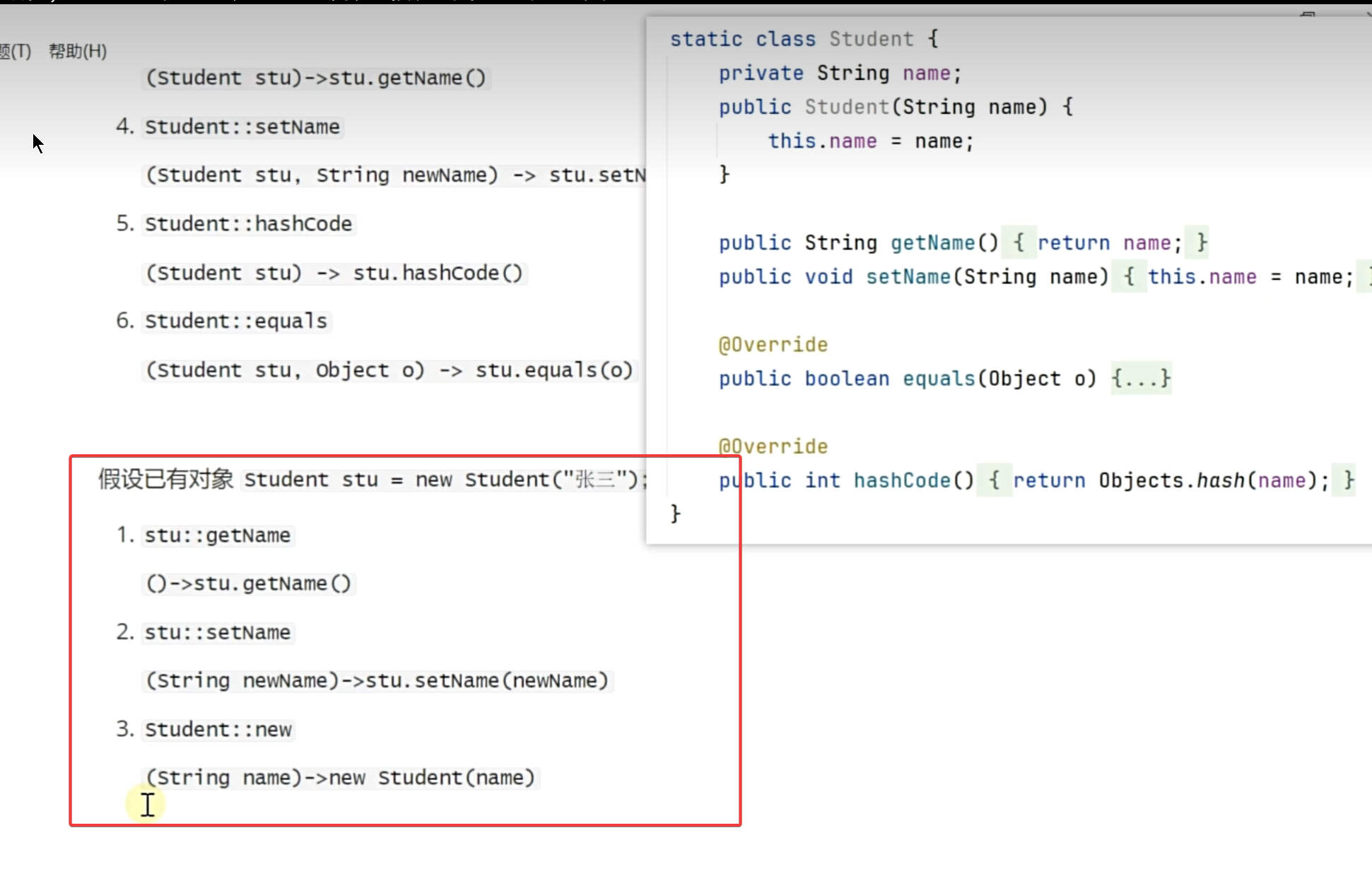
4.函数式编程的技巧(重要)
1.定义函数式接口:定义参数 + 返回值
2.Lambda表达式:根据参数和返回值写出逻辑
3.方法引用:根据逻辑反推出参数和返回值
2.函数对象的类型
1.如何归类?

2.归类练习
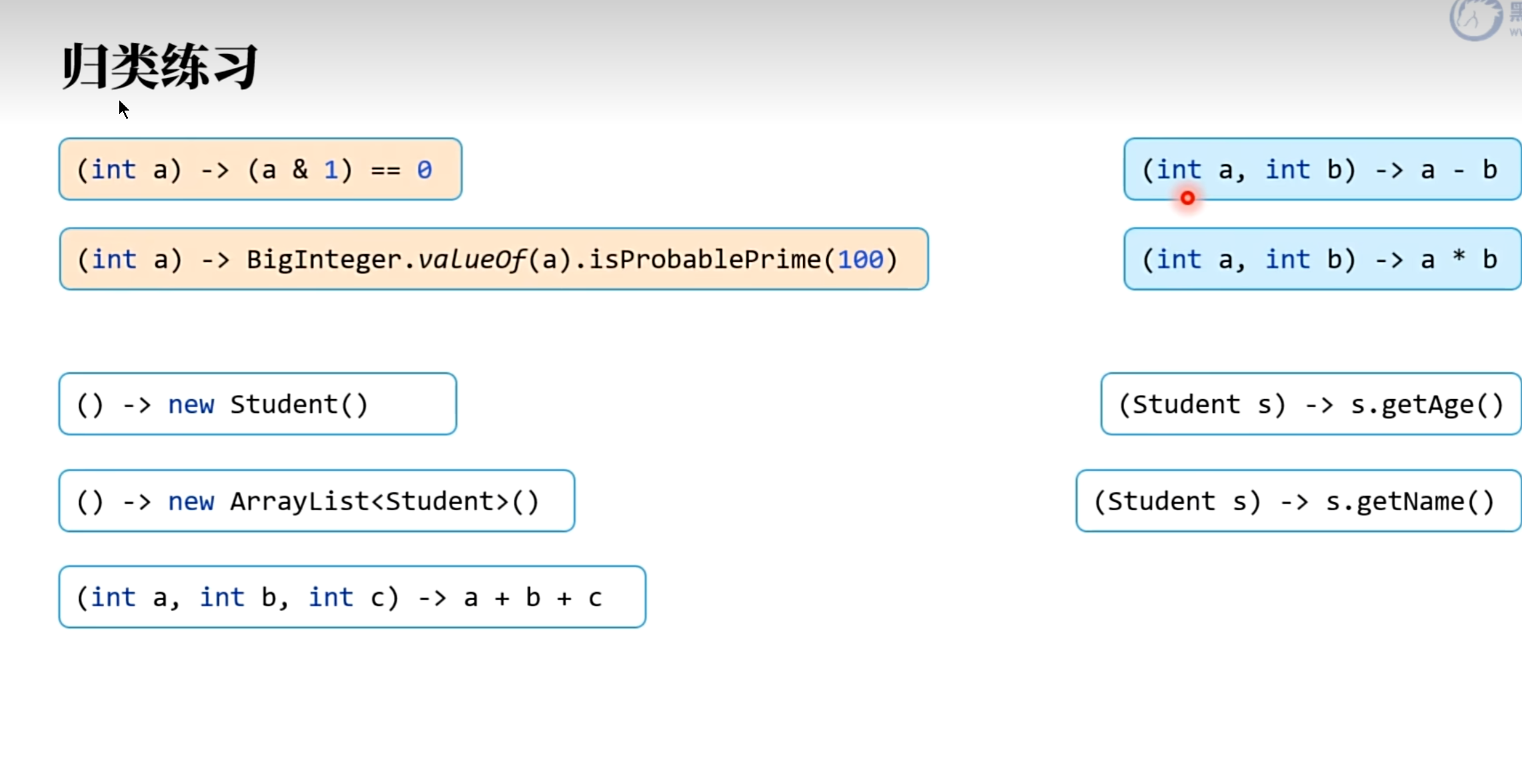
3.自定义函数式接口
1.函数式接口加上@FunctionalInterface 在编译时检查是否函数式接口有且只有一个抽象方法
package com.sun.first;
public class Sample2 {
public static void main(String[] args) {
Fun fun = (a) -> {
return a + 1;
};
System.out.println(fun.test(2));
}
}
@FunctionalInterface
interface Fun {
int test(int a);
}
2.练习案例
package com.sun.first;
import java.util.ArrayList;
public class Sample2 {
public static void main(String[] args) {
Fun fun = (a) -> {
return a + 1;
};
System.out.println(fun.test(2));
Fun1 fun1 = (int a, int b, int c) -> a + b + c;
Fun2 fun2 = (int a, int b) -> a - b;
Fun3 fun3 = () -> new String();
Fun4 fun4 = () -> new ArrayList<String>();
Fun5<String, Integer> fun5 = (str) -> {
return Integer.valueOf(str);
};
System.out.println(fun5.test("34"));
}
}
@FunctionalInterface
interface Fun {
int test(int a);
}
@FunctionalInterface
interface Fun1 {
int test(int a, int b, int c);
}
@FunctionalInterface
interface Fun2 {
int test(int a, int b);
}
@FunctionalInterface
interface Fun3 {
String test();
}
@FunctionalInterface
interface Fun4 {
ArrayList<String> test();
}
@FunctionalInterface
interface Fun5<I, O> {
O test(I input);
}
3.JDK提供的函数式接口
1.IntPredicate 参数为int,返回值为boolean

2.IntBinaryOperator 参数为两个int,返回值为int

3.Supplier 参数为空,返回值为泛型

4.Function 参数为泛型,返回值也为泛型

5.实例
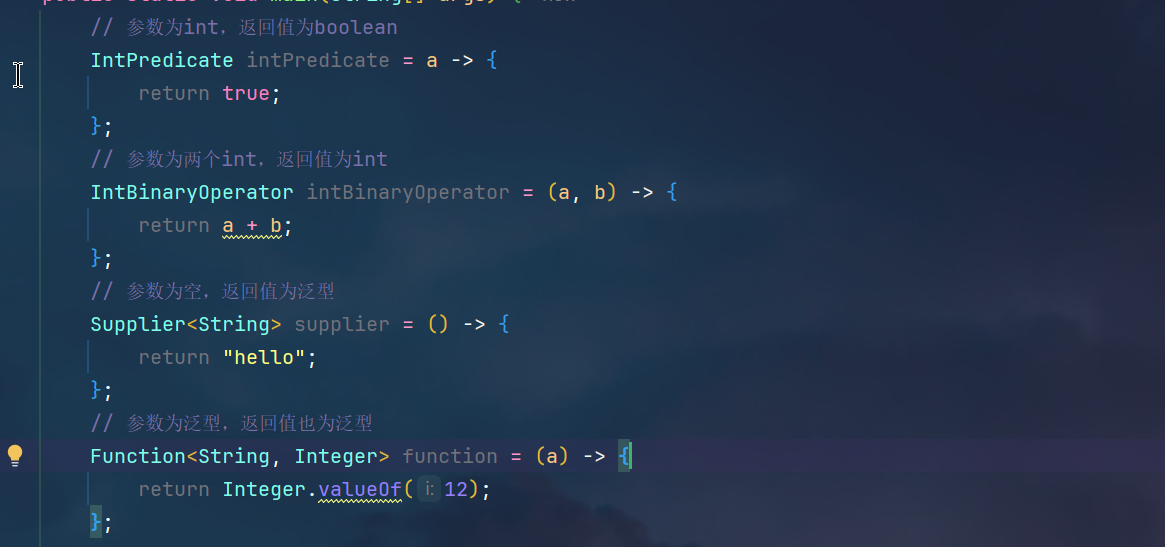
6.常见函数接口
1.概览
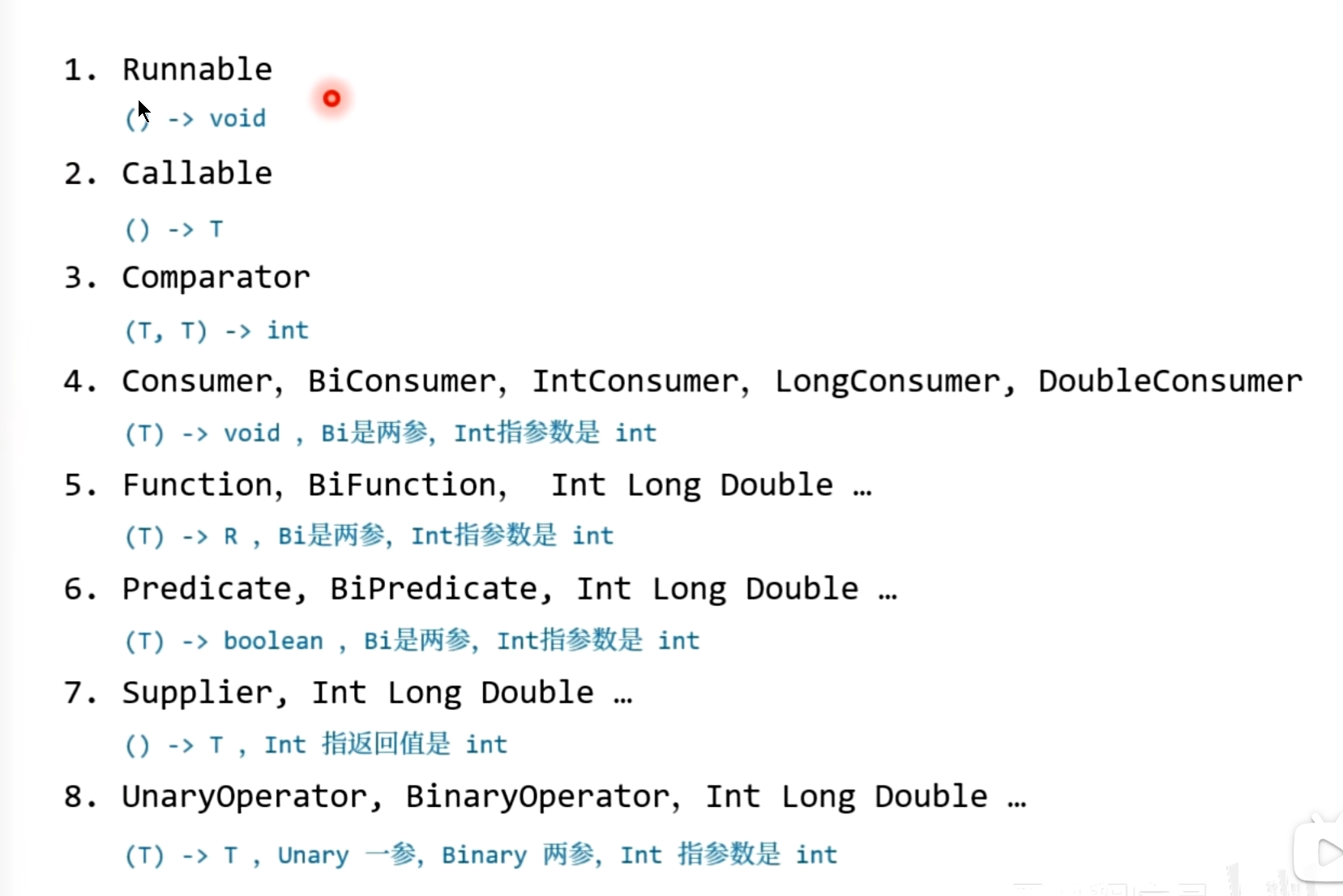
2.命名规则
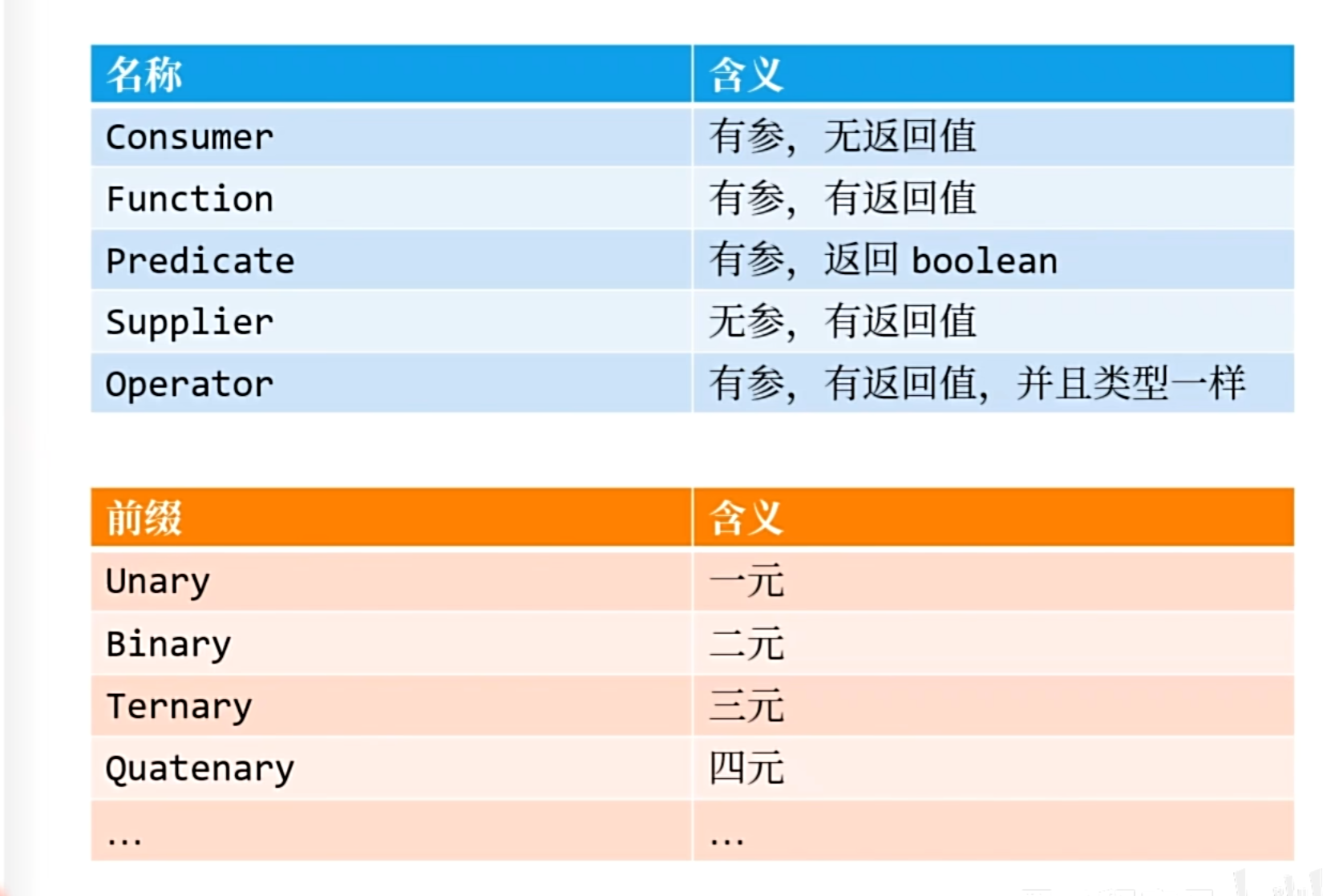
7.练习
1.将判断条件使用函数式接口替换 Predicate
1.题目
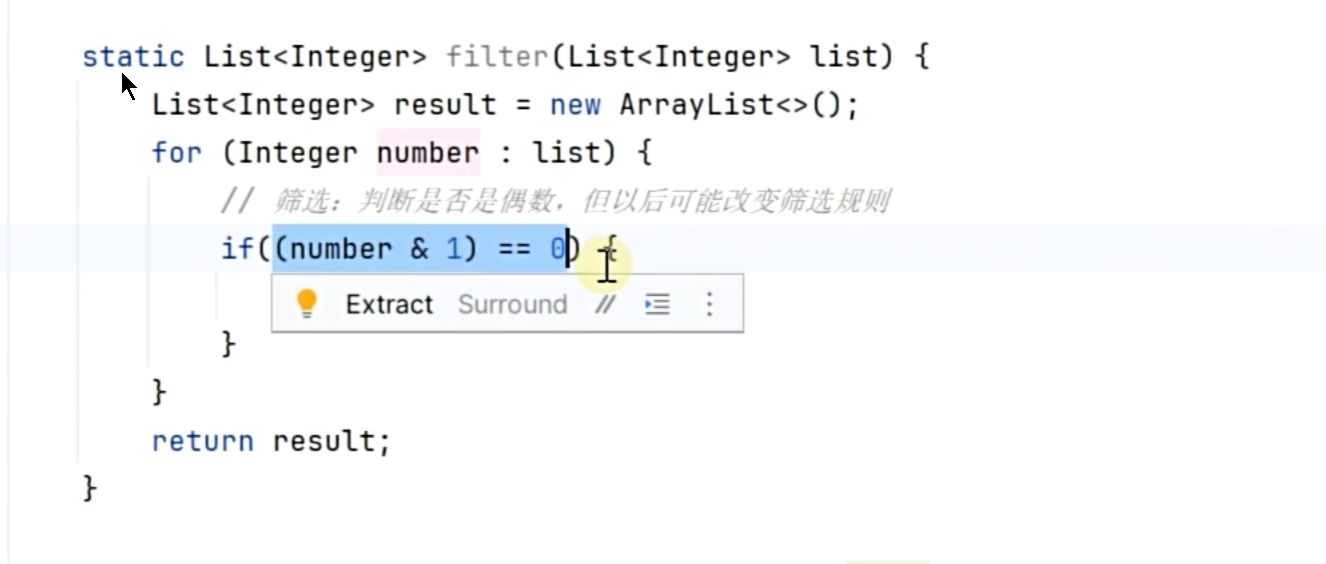
2.答案
package com.sun.first;
import java.util.ArrayList;
import java.util.Arrays;
import java.util.List;
import java.util.function.Predicate;
public class Sample4 {
public static void main(String[] args) {
List<Integer> filter = filter(Arrays.asList(1, 2, 3), i -> {
return (i & 1) == 0;
});
System.out.println("filter = " + filter);
}
static List<Integer> filter(List<Integer> list, Predicate<Integer> predicate) {
List<Integer> res = new ArrayList<>();
for (Integer i : list) {
if (predicate.test(i)) {
res.add(i);
}
}
return res;
}
}
2.一个参数一个返回值 Function
1.题目

2.答案
package com.sun.first;
import java.util.ArrayList;
import java.util.Arrays;
import java.util.List;
import java.util.function.Function;
public class Sample5 {
public static void main(String[] args) {
List<String> map = map(Arrays.asList(1, 2, 3), a -> {
return String.valueOf(a);
} );
System.out.println(map);
}
static List<String> map(List<Integer> list, Function<Integer, String> function) {
List<String> res = new ArrayList<>();
for (Integer i : list) {
res.add(function.apply(i));
}
return res;
}
}
3.将具体逻辑使用函数式接口替换 Consumer
1.题目

2.结果
package com.sun.first;
import java.util.Arrays;
import java.util.List;
import java.util.function.Consumer;
public class Sample6 {
public static void main(String[] args) {
consume(Arrays.asList(1, 3, 3), num -> {
System.out.println("num = " + num);
});
}
static void consume(List<Integer> list, Consumer<Integer> consumer) {
for(Integer num : list) {
consumer.accept(num);
}
}
}
4.没有参数,一个返回值 Supplier
1.题目

2.答案
package com.sun.first;
import java.util.ArrayList;
import java.util.List;
import java.util.concurrent.ThreadLocalRandom;
import java.util.function.Supplier;
public class Sample7 {
public static void main(String[] args) {
List<Integer> supply = supply(3, () -> {
int res = ThreadLocalRandom.current().nextInt();
System.out.println(res);
return res;
});
}
static List<Integer> supply(int count, Supplier<Integer> supplier) {
List<Integer> result = new ArrayList<>();
for (int i = 0; i < count; i++) {
result.add(supplier.get());
}
return result;
}
}
4.方法引用
1.基本介绍

2.六种方法引用的格式
1.类名::静态方法
1.介绍
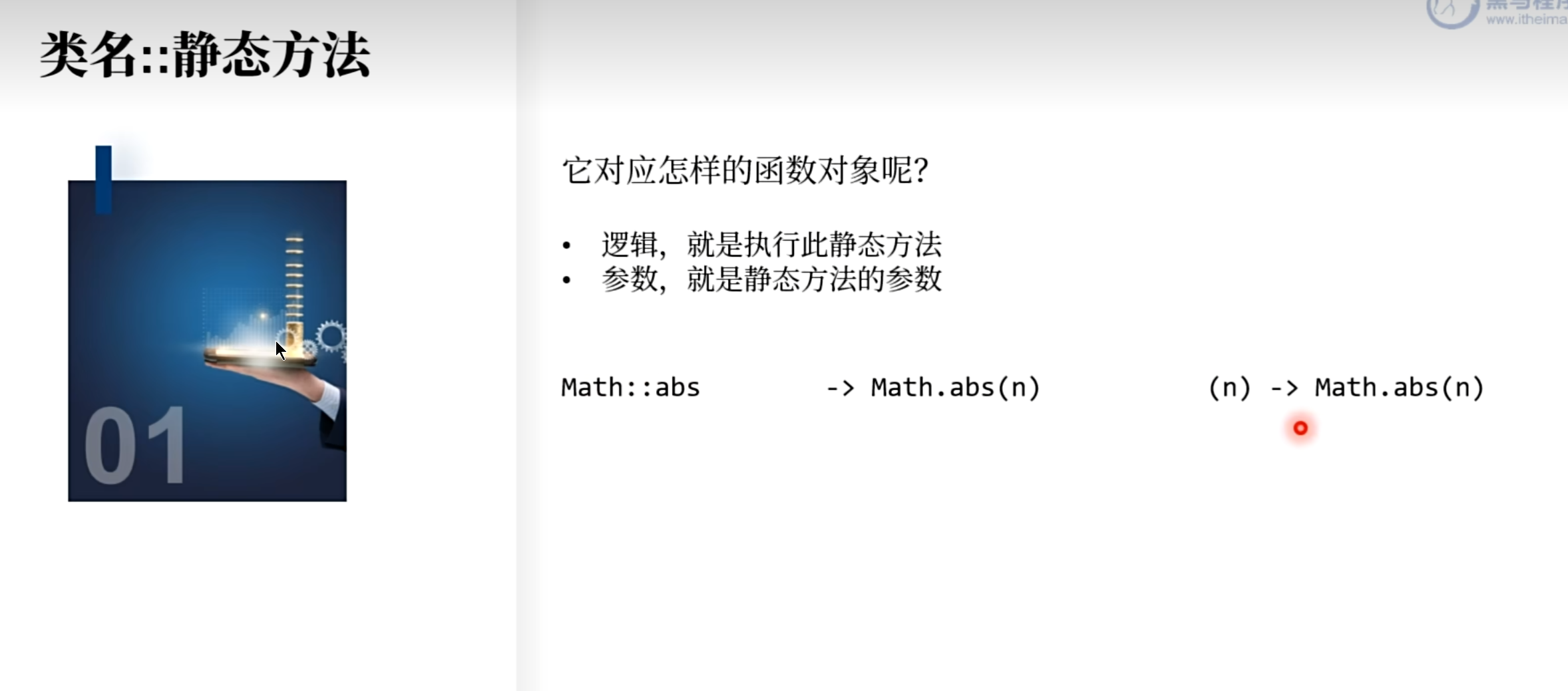
2.使用lambda表达式的方式,打印所有学生 forEach
package com.sun.methodref;
import java.util.stream.Stream;
public class MethodRef01 {
public static void main(String[] args) {
Stream.of(
new Student("libai", "男"),
new Student("dufu", "男"),
new Student("lishimin", "女")
).forEach(student -> {
System.out.println(student);
});
}
}
class Student {
private String name;
private String sex;
public String getName() {
return name;
}
public void setName(String name) {
this.name = name;
}
public String getSex() {
return sex;
}
public void setSex(String sex) {
this.sex = sex;
}
public Student(String name, String sex) {
this.name = name;
this.sex = sex;
}
@Override
public String toString() {
return "Student{" +
"name='" + name + '\'' +
", sex='" + sex + '\'' +
'}';
}
}
3.使用方法引用,打印所有学生 forEach
public class MethodRef01 {
public static void main(String[] args) {
Stream.of(
new Student("libai", "男"),
new Student("dufu", "男"),
new Student("lishimin", "女")
).forEach(MethodRef01::abc);
}
public static void abc(Student student) {
System.out.println(student);
}
}
4.使用lambda表达式的方式,打印所有男学生 filter
public static void main(String[] args) {
Stream.of(
new Student("libai", "男"),
new Student("dufu", "男"),
new Student("lishimin", "女")
).filter(student -> {
if (student.getSex().equals("男")) {
return true;
}
return false;
})
.forEach(MethodRef01::abc);
}
public static void abc(Student student) {
System.out.println(student);
}
}
5.使用方法引用的方式,打印所有男学生 filter
public static void main(String[] args) {
Stream.of(
new Student("libai", "男"),
new Student("dufu", "男"),
new Student("lishimin", "女")
).filter(MethodRef01::filter).
forEach(MethodRef01::abc);
}
public static boolean filter(Student student) {
return student.getSex().equals("男");
}
public static void abc(Student student) {
System.out.println(student);
}
2.类名:非静态方法
1.介绍
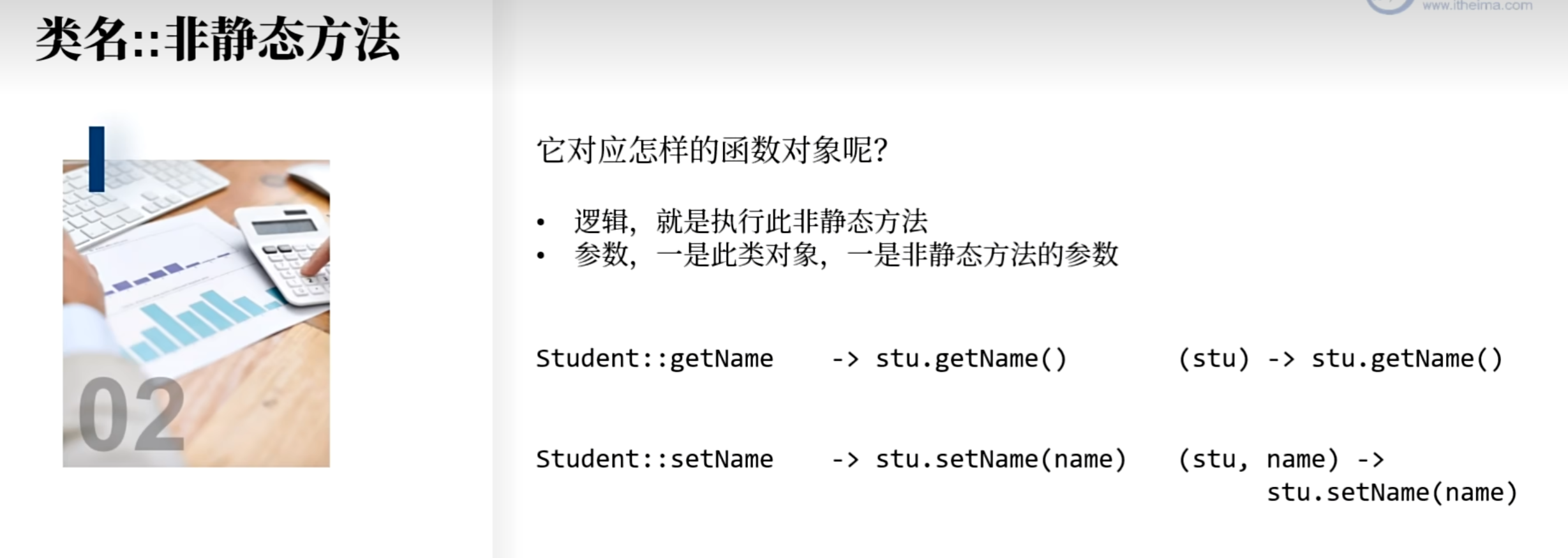
2.使用lambda表达式的方式,打印所有男学生 filter
public static void main(String[] args) {
Stream.of(
new Student("libai", "男"),
new Student("dufu", "男"),
new Student("lishimin", "女")
).filter(student -> {
return student.isMale(student);
})
.forEach(MethodRef01::abc);
}
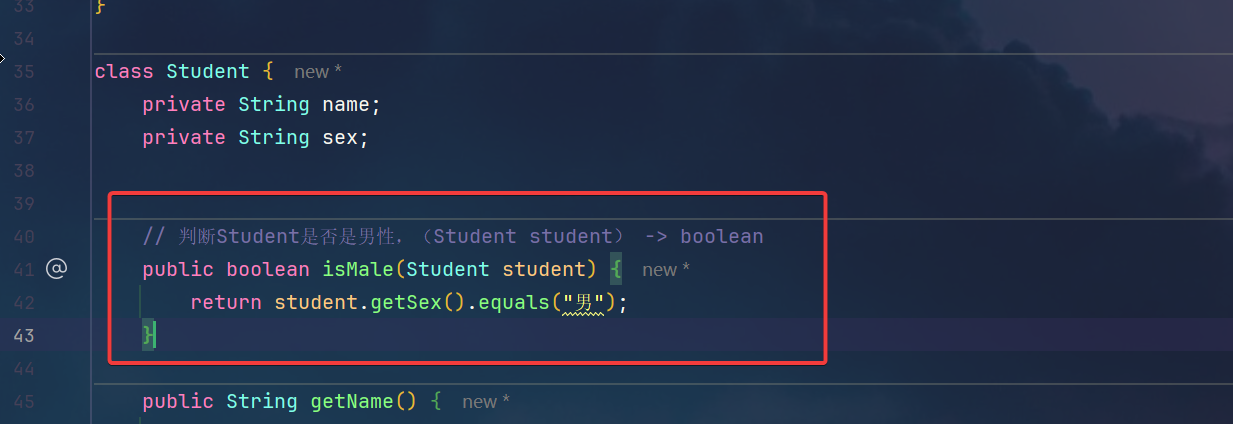
3.使用方法引用的方式,打印所有男学生 filter
public void main(String[] args) {
Stream.of(
new Student("libai", "男"),
new Student("dufu", "男"),
new Student("lishimin", "女")
).filter(Student::isMale)
.forEach(MethodRef01::abc);
}

3.对象:非静态方法
1.介绍
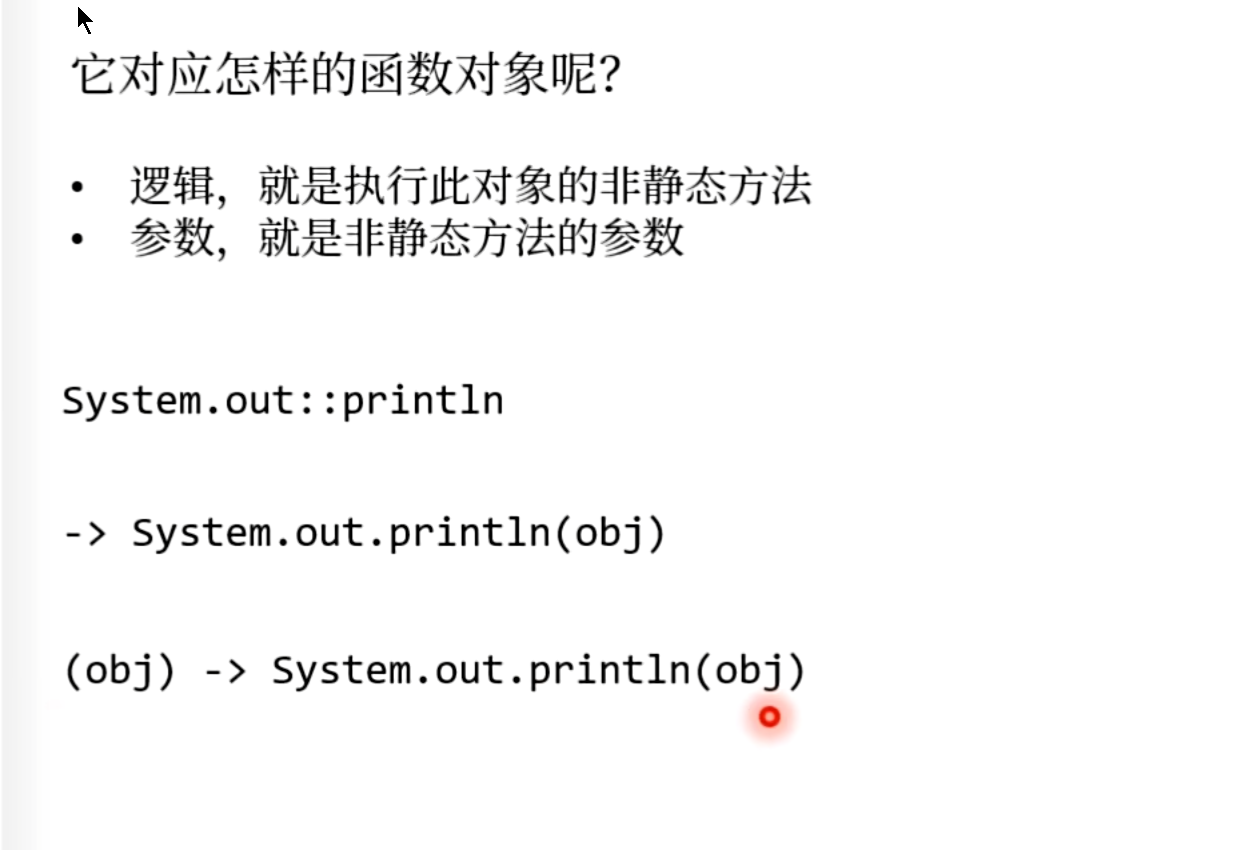
2.输出

3.过滤性别是男的

4.将男生转化为女生
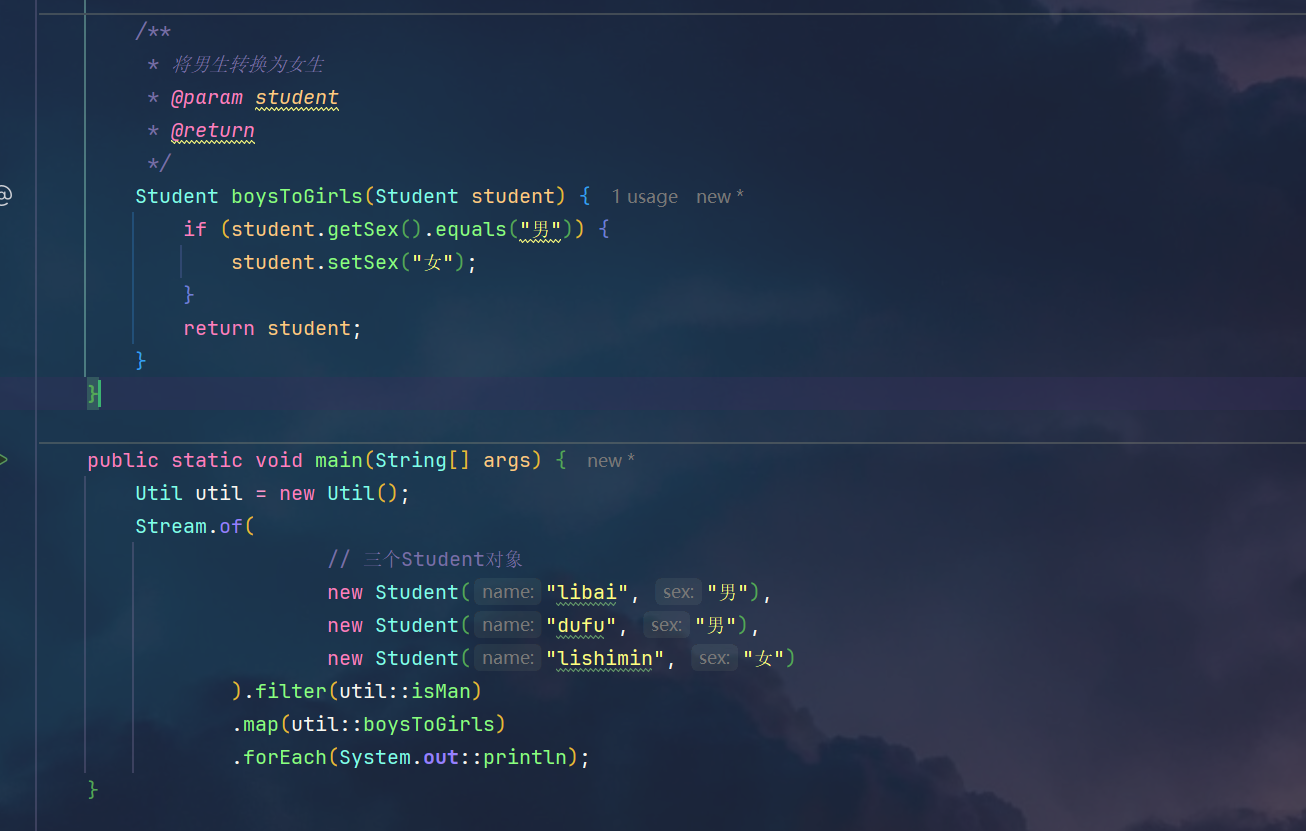
4.类名::new
1.介绍
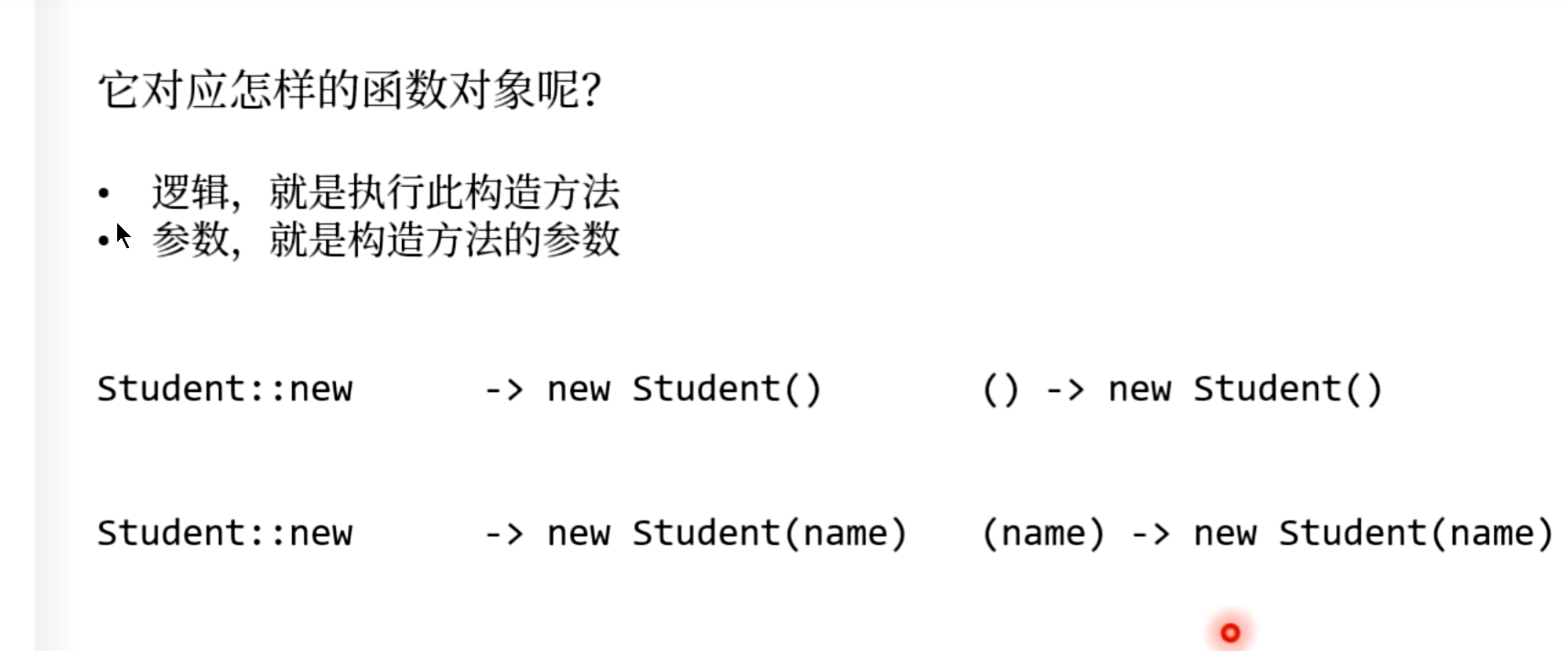
2.调用不同参数个数的构造
package com.sun.first;
import java.util.function.BiFunction;
import java.util.function.Function;
import java.util.function.Supplier;
public class Sample9 {
public static void main(String[] args) {
Supplier<Student> m1 = Student::new;
Student student = m1.get();
System.out.println("student = " + student);
Function<String, Student> m2 = Student::new;
Student sun = m2.apply("sun");
System.out.println("sun = " + sun);
BiFunction<String, String, Student> m3 = Student::new;
Student apply = m3.apply("sun", "男");
System.out.println("apply = " + apply);
}
}
5.this::非静态方法和super::非静态方法
1.使用this过滤男性
package com.sun.first;
import java.util.stream.Stream;
public class Sample10 {
Boolean isMan(Student student) {
return student.getSex().equals("男");
}
public void main(String[] args) {
Stream.of(
new Student("libai", "男"),
new Student("dufu", "男"),
new Student("lishimin", "女")
).filter(this::isMan);
}
}
2.使用super过滤男性
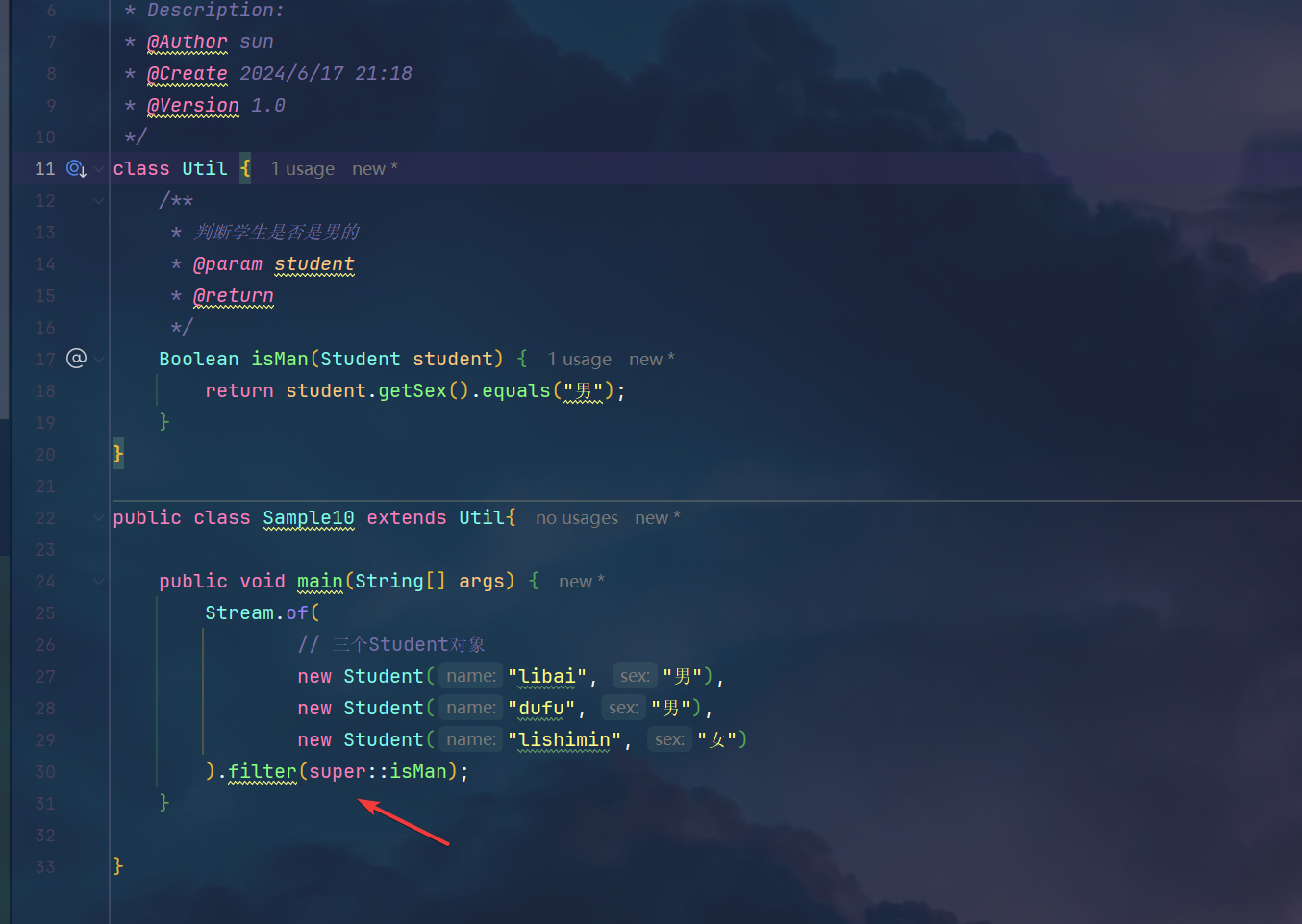
6.六种使用方式对比
